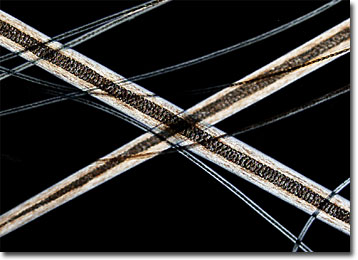Polarized Light Microscopy Digital Image Gallery
Muskrat Hair
Members of the family Cricetidae, muskrats have a long history of demand in the fur industry. Thus the aquatic rodents, which are only native to North America, may also be found in Europe, Russia, China, and a variety of other areas due to the introduction of populations for commercial purposes.

View a second image of Muskrat Hair
Most muskrats resemble house rats in appearance, but are significantly larger, their bodies reaching lengths as great as 14 inches. Also, their tails, which may grow up to 10 inches long, are flattened in a vertical direction and their powerful hind feet that help smoothly propel them through the water are partially webbed. Muskrats are generally solitary animals that live alone in burrows or lodgings composed of reeds or other marsh vegetation. They mark these domiciles and surrounding landmarks as components of their home territory by excreting a yellowish, pungent substance produced by the musk glands. This substance is sometimes utilized in the perfume industry.
The fur of muskrats consists of an outer, relatively rigid layer of long guard hairs and a soft, dense underlayer that provides warmth and buoyancy to the rodent, and which is commonly utilized in the fur trade. Extremely fine and usually blackish or reddish brown in color, this underlying fur is often utilized to make coats, earmuffs, and similar items. When readied for the marketplace the muskrat pelts are often dyed to look more closely akin to other, more costly, furs. It is also sold under varying, more luxurious sounding names, such as river mink.
